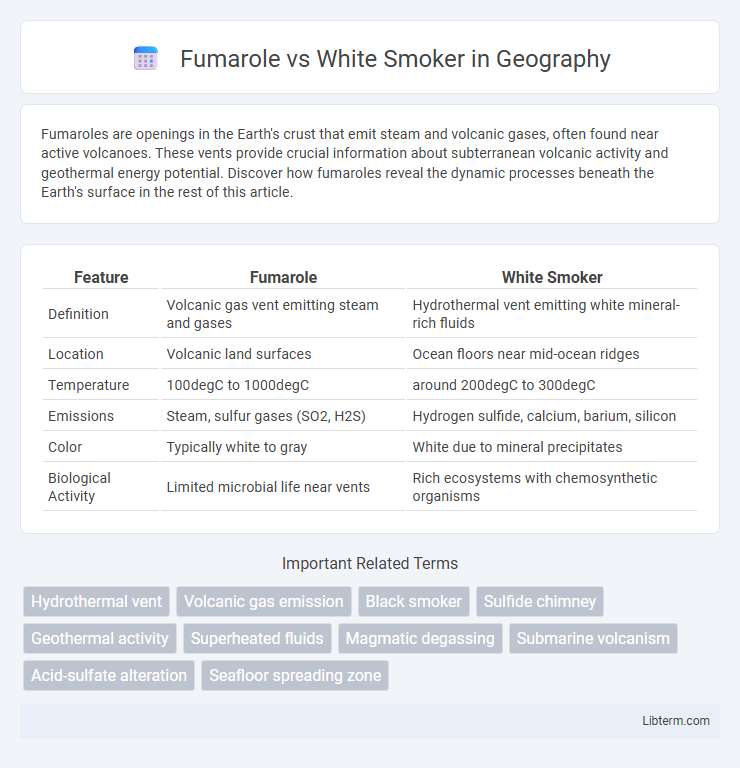Fumaroles are openings in the Earth's crust that emit steam and volcanic gases, often found near active volcanoes. These vents provide crucial information about subterranean volcanic activity and geothermal energy potential. Discover how fumaroles reveal the dynamic processes beneath the Earth's surface in the rest of this article.
Table of Comparison
| Feature | Fumarole | White Smoker |
|---|---|---|
| Definition | Volcanic gas vent emitting steam and gases | Hydrothermal vent emitting white mineral-rich fluids |
| Location | Volcanic land surfaces | Ocean floors near mid-ocean ridges |
| Temperature | 100degC to 1000degC | around 200degC to 300degC |
| Emissions | Steam, sulfur gases (SO2, H2S) | Hydrogen sulfide, calcium, barium, silicon |
| Color | Typically white to gray | White due to mineral precipitates |
| Biological Activity | Limited microbial life near vents | Rich ecosystems with chemosynthetic organisms |
Introduction to Hydrothermal Vents
Hydrothermal vents are fissures on the seafloor that emit geothermally heated water rich in minerals and gases. Fumaroles release hot gases primarily composed of steam and volcanic gases like sulfur dioxide, while white smokers discharge cooler, mineral-laden fluids forming white, particle-rich plumes. These distinct vent types support unique chemosynthetic ecosystems, playing a crucial role in deep-sea biodiversity and biogeochemical cycles.
What is a Fumarole?
A fumarole is a vent in the Earth's crust that emits steam and volcanic gases such as sulfur dioxide and carbon dioxide at high temperatures, often exceeding 200degC. Unlike white smokers, which discharge mineral-rich hydrothermal fluids and form chimney-like structures on the ocean floor, fumaroles release primarily gaseous emissions and are commonly found in volcanic areas on land. These features provide critical insights into volcanic activity and geothermal processes by indicating the presence of magma and hydrothermal systems beneath the surface.
Defining White Smokers
White smokers are hydrothermal vent systems found on the ocean floor, characterized by the emission of cooler, mineral-rich fluids that form white, cloudy plumes primarily composed of barium, calcium, and silicon compounds. Unlike fumaroles, which release high-temperature volcanic gases such as steam and sulfur dioxide above ground, white smokers operate underwater and support unique ecosystems relying on chemosynthesis. These vents play a critical role in oceanic mineral cycling and provide habitats for specialized marine organisms adapted to their chemically distinct environments.
Key Differences Between Fumaroles and White Smokers
Fumaroles are volcanic vents emitting hot gases such as sulfur dioxide, carbon dioxide, and steam at temperatures often exceeding 500degC, primarily found on land above magma chambers. White smokers are underwater hydrothermal vents releasing cooler, mineral-rich fluids around 200-300degC, characterized by white-colored plumes formed from lighter sulfide minerals like barium, calcium, and silicon compounds. The key differences include their environment (terrestrial vs. marine), emission composition (gas-rich fumaroles vs. mineral-laden water in white smokers), and temperature range, reflecting distinct geothermal processes.
Geological Formation Processes
Fumaroles form when volcanic gases escape through cracks in the Earth's crust, releasing steam and sulfur-rich gases produced by magma heating groundwater. White smokers arise on the seafloor at hydrothermal vents, where superheated mineral-laden fluids precipitate white-colored sulfide and sulfate minerals upon mixing with cold seawater. Both geological formation processes involve the interaction of heat, water, and mineral content, but fumaroles develop primarily on volcanic land surfaces, while white smokers occur in deep oceanic rifts.
Chemical Composition and Emissions
Fumaroles emit gases rich in sulfur dioxide (SO2), carbon dioxide (CO2), hydrogen sulfide (H2S), and steam, often reaching temperatures above 300degC. White smokers primarily release cooler, alkaline fluids containing barium, calcium, silicon, and methane, with temperatures typically below 200degC. The chemical composition of fumarole emissions is dominated by volcanic gases, while white smokers discharge hydrothermal fluids resulting from subseafloor seawater-rock interactions.
Ecosystems Around Fumaroles vs White Smokers
Ecosystems around fumaroles feature specialized extremophiles such as thermophilic bacteria and archaea that thrive in high-temperature, gas-rich environments dominated by sulfur and other volcanic gases. White smokers support unique biological communities, including tube worms, clams, and mussels, adapted to cooler, mineral-rich hydrothermal fluids rich in sulfides. Both ecosystems rely on chemosynthesis but differ in species composition and energy sources due to varying temperature and chemical gradients.
Global Locations and Distribution
Fumaroles are commonly found along tectonic plate boundaries, especially in regions with active volcanoes such as the Pacific Ring of Fire, including locations like Yellowstone National Park in the USA, Japan, and Italy's Campi Flegrei. White smokers, typically located at mid-ocean ridges like the East Pacific Rise and the Mid-Atlantic Ridge, are hydrothermal vents emitting mineral-rich, cooler fluid with a light-colored plume. Both fumaroles and white smokers contribute to unique geothermal and marine ecosystems but differ distinctly in their global distribution, with fumaroles predominating on land and white smokers occurring primarily on the ocean floor.
Scientific Importance and Research
Fumaroles emit high-temperature gases rich in sulfur compounds, providing critical insights into volcanic gas compositions and geothermal processes essential for monitoring volcanic activity. White smokers, characterized by cooler, mineral-rich hydrothermal fluids, offer valuable information on submarine hydrothermal vent ecosystems and metal deposit formation. Studying both features enhances understanding of geochemical cycles, microbial life in extreme environments, and Earth's geothermal energy potential.
Environmental Impact and Hazards
Fumaroles release sulfurous gases like hydrogen sulfide that contribute to acid rain, causing localized environmental damage and respiratory hazards to humans and wildlife. White smokers emit mineral-rich hydrothermal fluids, supporting unique deep-sea ecosystems but potentially dispersing toxic metals into marine environments. Both phenomena pose risks through the release of toxic substances, but fumaroles tend to impact air quality while white smokers primarily affect underwater habitats.
Fumarole Infographic

 libterm.com
libterm.com